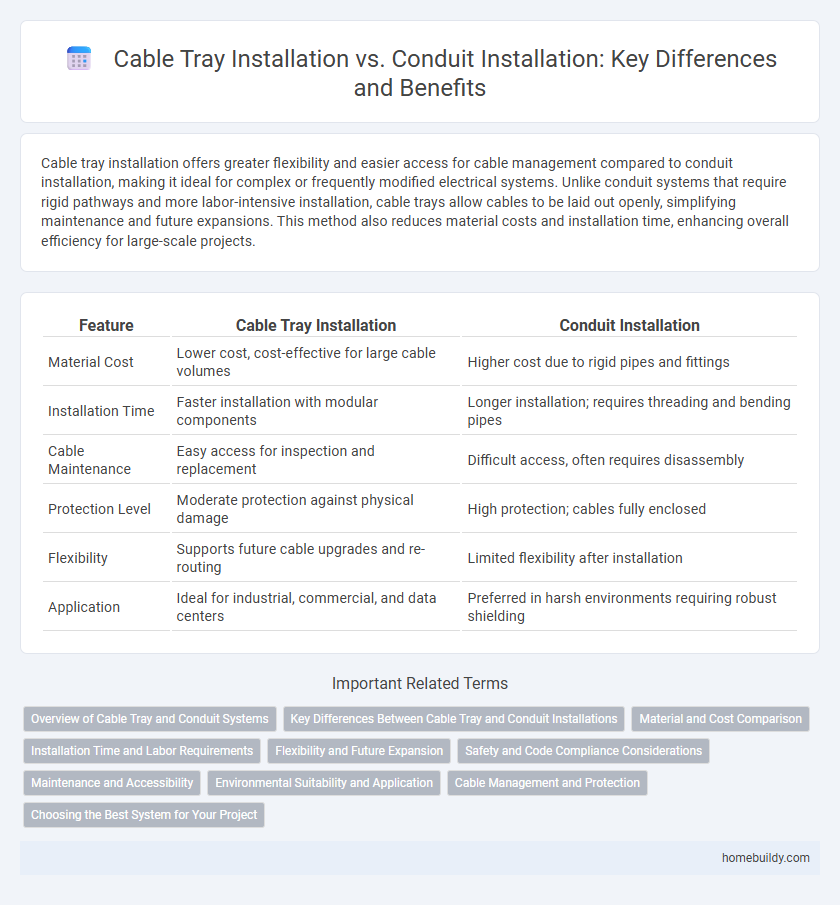Cable tray installation offers greater flexibility and easier access for cable management compared to conduit installation, making it ideal for complex or frequently modified electrical systems. Unlike conduit systems that require rigid pathways and more labor-intensive installation, cable trays allow cables to be laid out openly, simplifying maintenance and future expansions. This method also reduces material costs and installation time, enhancing overall efficiency for large-scale projects.
Table of Comparison
| Feature | Cable Tray Installation | Conduit Installation |
|---|---|---|
| Material Cost | Lower cost, cost-effective for large cable volumes | Higher cost due to rigid pipes and fittings |
| Installation Time | Faster installation with modular components | Longer installation; requires threading and bending pipes |
| Cable Maintenance | Easy access for inspection and replacement | Difficult access, often requires disassembly |
| Protection Level | Moderate protection against physical damage | High protection; cables fully enclosed |
| Flexibility | Supports future cable upgrades and re-routing | Limited flexibility after installation |
| Application | Ideal for industrial, commercial, and data centers | Preferred in harsh environments requiring robust shielding |
Overview of Cable Tray and Conduit Systems
Cable tray systems provide organized support for electrical cables, allowing easy access for maintenance and future expansion, while conduit systems offer robust protection by encasing cables in rigid or flexible tubes, ideal for environments requiring enhanced mechanical defense. Cable trays are favored in commercial and industrial settings for their flexibility and capacity to handle large cable volumes, whereas conduits are preferred in situations demanding stringent protection against physical damage and environmental factors. Choosing between cable tray and conduit installation depends on factors such as installation complexity, cost, accessibility, and the specific environmental conditions of the project site.
Key Differences Between Cable Tray and Conduit Installations
Cable tray installations provide an open support system for electrical cables, allowing easy access for maintenance and modifications, while conduit installations offer enclosed pathways that protect cables from physical damage and environmental factors. Cable trays are generally more cost-effective and quicker to install for large cable runs, whereas conduits are preferred in areas requiring higher protection and compliance with stringent safety codes. The choice between cable tray and conduit installations depends on project requirements such as cable volume, environmental conditions, and accessibility needs.
Material and Cost Comparison
Cable tray installation typically uses aluminum or galvanized steel, offering lightweight durability and corrosion resistance, while conduit installation often relies on steel or PVC, which may increase rigidity but affect flexibility. Material costs for cable trays are generally lower, especially in large-scale projects, due to easier handling and faster installation compared to conduit systems that require more fittings and labor. Overall, cable trays provide a cost-effective solution with reduced maintenance expenses, whereas conduit installations incur higher initial costs but offer enhanced protection in harsh environments.
Installation Time and Labor Requirements
Cable tray installation typically requires less time and labor compared to conduit installation due to its modular design and ease of assembly. Cable trays allow for faster cable laying and modifications without extensive dismantling, reducing overall installation labor costs. In contrast, conduit installation involves more complex routing and fitting, increasing both installation time and the need for specialized labor.
Flexibility and Future Expansion
Cable tray installation offers superior flexibility compared to conduit systems by allowing easy access for cable additions, modifications, or rerouting without extensive demolition or rework. Its open structure supports future expansion efficiently, accommodating extra cables and enabling rapid adjustments to changing electrical layouts. Conduit installation, while providing robust protection, often requires re-pulling cables through confined spaces, limiting adaptability and increasing labor costs during upgrades.
Safety and Code Compliance Considerations
Cable tray installation offers enhanced safety by providing better heat dissipation and easier access for maintenance compared to conduit systems, which can trap heat and complicate inspections. Compliance with National Electrical Code (NEC) Article 392 ensures cable trays are used appropriately for supporting and routing electrical conductors while meeting fire protection and grounding requirements. Proper installation following these codes reduces the risk of electrical hazards and promotes safer, more efficient infrastructure in commercial and industrial settings.
Maintenance and Accessibility
Cable tray installation offers superior maintenance and accessibility compared to conduit installation by providing open pathways that allow easy visual inspection, quick cable additions, and straightforward repairs. Unlike conduits, which often require cutting or dismantling for access, cable trays enable technicians to manage cables without disrupting the entire system. This accessibility reduces downtime and lowers maintenance costs in complex electrical installations.
Environmental Suitability and Application
Cable tray installation offers superior environmental suitability in corrosive or high-moisture areas due to its open design, allowing better ventilation and easier inspection. Conduit installation provides enhanced protection against physical damage and is ideal for hazardous or high-security environments where enclosed wiring is critical. Application-wise, cable trays are preferred in large-scale industrial or commercial projects with frequent wiring changes, while conduits are suited for residential or small-scale installations requiring more rigid protection.
Cable Management and Protection
Cable tray installation simplifies cable management by providing an organized, accessible pathway for multiple cables, reducing clutter and easing maintenance compared to conduit systems. Unlike conduits, cable trays offer superior ventilation, which minimizes heat buildup and extends cable lifespan, enhancing overall protection. The open design of cable trays also allows for easier modifications and expansions, optimizing adaptability in complex electrical installations.
Choosing the Best System for Your Project
Cable tray installation offers superior flexibility and easier access for future cable management compared to conduit installation, making it ideal for large-scale or frequently modified electrical projects. Conduits provide enhanced protection against environmental hazards and physical damage, which suits projects requiring high durability and secure cable pathways. Evaluating project-specific factors such as installation complexity, maintenance needs, and environmental conditions is essential for selecting the most efficient system.
Cable tray installation vs conduit installation Infographic

 homebuildy.com
homebuildy.com